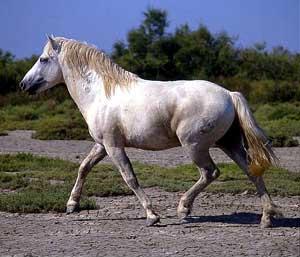Camargue
Horse of the sea
Mon, 28th April, 2025 - 7:03 pm GMT
Sponsor Ads:

Alternative Name
Horse of the seaBasic Info
The Camargue horse is born black or brown and turns gray with maturity. They stand between 13 - 14 hands. They have a large and square head with a straight or slightly convex profile. The eyes are large and expressive and the ears are broad and short with a broad base. The neck is short and muscular, deep at the base, the withers are pronounced, the back is straight and short. The croup is short and narrow, the chest wide and deep. The shoulder is rather straight and quite short; the mane and tail are long and thick. The legs are extremely hardy with clean joints, a long forearm, and very good hooves. They are not shod
Health
N/AHabitat
N/ABehavior
Camargue is an even-tempered horse, lively, agile, brave and very hardy. It is capable of enduring bad weather and long periods without food, as well as travelling long distances. Its infallible instinct and broad, steady hooves mean that it is perfectly adapted to its watery environment. The Camargue is particularly suited for riding.Origin
south of FranceHistory
The Camargue is one of the oldest breeds in the world. The area where the Camargue is bred is contained within a triangle in the south of France. Montpellier is to the west, Tarascon to the north and Fos to the east, passing through Salon de Provence, an area which thus encompasses the "Ile de Camargue ", the plains of the Gard and the Hérault, and part of the Crau. In 1928 the Camargue Regional Park was established to protect the horses and cattle of Camargue from human encroachment. The climate of the Camargue is harsh, being either scorchingly hot beneath a fierce sun or whipped by icy winds blowing from the Alps. The Camargue, often called "the horse of the sea," has existed in this region since prehistoric times. Some suggest it is a descendant of the now extinct Soutré horse, whose bones were found in the southeast of France yet its exact origins are still shrouded in mystery. Through the centuries many armies have passed by the Camargue, including the Greeks, Romans and Arabs. The horses brought with these armies influenced the Camargue over time. It has even been suggested that the Camargue has had some influence on the early breeds in Spain as armies took them back home. The horses of the Camargue run wild in the marshlands in small herds consisting of one stallion, his mares and progeny. The fillies are usually caught and branded as yearlings and colts thought to be unsuitable for breeding are gelded at three years old. The breed is strictly protected today. Breeding is semi-wild but under supervision of the Biological Research Station of la Tour du Valat. Because of their somewhat isolated environment, humans have been able to observe the social interactions and lifestyles of wild horses. The Camargue has contributed greatly to human understanding of equine behavior that might have otherwise never been researched. The Camargue is a rugged horse and breeds very true to type -- to the extent that it can be difficult to tell one from another. This horse is lively but has a good nature and when trained to ride is used to mange the bull herd in the delta as well as provide visitors the opportunity to explore the region by horseback.Common Foods
grassSponsor Ads:
Enthusiasm wanes, but dullness lasts forever. -- Unknown
Camargue
Coded by: BGID® | ALL RIGHTS RESERVED Copyright © 2000-2025
Disclaimer | Privacy | Report Errors / Contact | Credits
















